The Païolive forest near Les Vans |
The Païolive forest stretches like a mineral and vegetal labyrinth on the edge of the Ardèche department near Les Vans. This ancient forest is distinguished by its jumble of limestone rocks sculpted by erosion over millennia. The petrified formations create strange silhouettes, the most famous of which are undoubtedly the bear and the lion. Among these grey rocks flourishes a white and green oak grove, home to exceptional and often protected biodiversity. The site is crisscrossed by numerous hiking trails, such as the ridge trail offering views of the Chassezac River. This river flows below and has carved spectacular gorges that border this very ancient limestone plateau. Local legends tell of this rugged landscape, the work of mysterious forces or battles between giants.

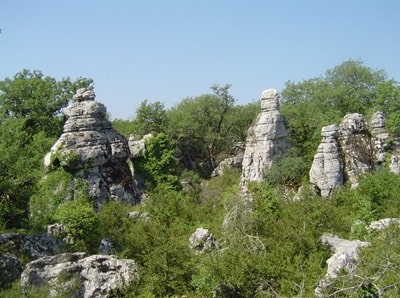 Imagine an enchanted forest, where stones take on fantastic shapes, where animals hide among the trees, and where rivers sing and whisper. Welcome to the Paiolive Forest, a sanctuary of nature inviting discovery and wonder.
Imagine an enchanted forest, where stones take on fantastic shapes, where animals hide among the trees, and where rivers sing and whisper. Welcome to the Paiolive Forest, a sanctuary of nature inviting discovery and wonder.
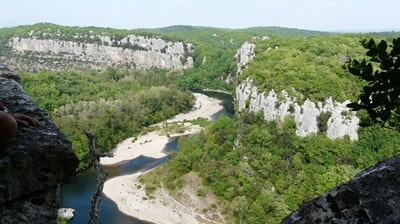 Paiolive Forest is located at the borders of three departments: Ardèche, Gard, and Lozère. It spans three communes: Les Vans, Banne, and Berrias-et-Casteljau. It is nestled at the foot of the Cévennes, between the Rhône-Alpes and Languedoc-Roussillon regions. It is about 30 kilometers from Aubenas, the sub-prefecture of Ardèche. It has been passed by humans for over 50,000 years. They left traces of their passage in caves and rock shelters. They also erected dolmens, these ancient tomb monuments, that testify to their respect for the dead.It has seen the rise of early civilizations: those who tamed the land and fire. They created pottery, tools, and jewelry. They cultivated vineyards, olives, and wheat. They shaped the landscape with stone walls, terraces, and huts.
Paiolive Forest is located at the borders of three departments: Ardèche, Gard, and Lozère. It spans three communes: Les Vans, Banne, and Berrias-et-Casteljau. It is nestled at the foot of the Cévennes, between the Rhône-Alpes and Languedoc-Roussillon regions. It is about 30 kilometers from Aubenas, the sub-prefecture of Ardèche. It has been passed by humans for over 50,000 years. They left traces of their passage in caves and rock shelters. They also erected dolmens, these ancient tomb monuments, that testify to their respect for the dead.It has seen the rise of early civilizations: those who tamed the land and fire. They created pottery, tools, and jewelry. They cultivated vineyards, olives, and wheat. They shaped the landscape with stone walls, terraces, and huts.
Paiolive Forest has experienced adventures that inspired novelists. It was the refuge for rebels, resistance fighters, and lovers. It was the setting for Firmin Boissin’s novel, "Jan of the Moon," which tells the story of a young man fighting for freedom and love. "Jean of the Moon in Paiolive Forest" is an Ardèche legend about a young man named Jean who lived in the region of the Paiolive woods, in Ardèche, France.
According to legend, Jean was in love with a young girl from the village, but their love was forbidden by her parents. One evening, desperate, Jean decided to leave the village and seek refuge in the Paiolive forest. There, he wandered, searching for meaning to his life and a solution to his sorrow. It is said that he wandered so long in the woods that he eventually disappeared and transformed into a mysterious figure known as Jean of the Moon, a benevolent spirit watching over the forest and its inhabitants. Some even say you can still see Jean of the Moon wandering among the trees on full moon nights, seeking peace and love.
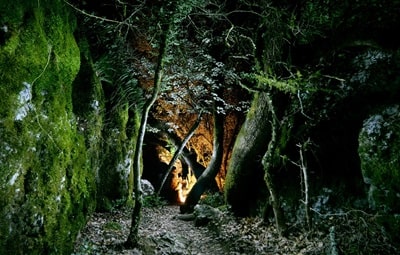 Paiolive Forest is a treasure, a gift of nature. It consists of limestone rocks dating back 180 million years. These have been sculpted by erosion, creating wonders—gorges where the Chassezac river flows, clear and lively. Lapiaz, with fissures and crevasses. Chaos, where stone blocks are piled up. Sculptures resembling animals, faces, or figures.
Paiolive Forest is a treasure, a gift of nature. It consists of limestone rocks dating back 180 million years. These have been sculpted by erosion, creating wonders—gorges where the Chassezac river flows, clear and lively. Lapiaz, with fissures and crevasses. Chaos, where stone blocks are piled up. Sculptures resembling animals, faces, or figures.
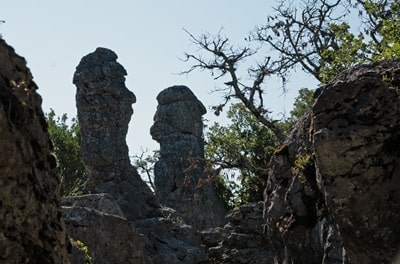 Paiolive Forest is an ecosystem, home to a rich biodiversity. It hosts many natural habitats, supporting a variety of plant and animal species. Aquatic environments with riverbank plants like willows, alders, reeds. Rocky habitats with plants like saxifrages, houseleeks, orchids. Old forests with majestic trees like white oaks, green oaks, pines. Garrigue and dry grasslands where Mediterranean plants like thyme, rosemary, and lavender bloom.
Paiolive Forest is an ecosystem, home to a rich biodiversity. It hosts many natural habitats, supporting a variety of plant and animal species. Aquatic environments with riverbank plants like willows, alders, reeds. Rocky habitats with plants like saxifrages, houseleeks, orchids. Old forests with majestic trees like white oaks, green oaks, pines. Garrigue and dry grasslands where Mediterranean plants like thyme, rosemary, and lavender bloom.
Paiolive Forest remains a mystery deeply rooted underground. It contains caves and springs connected through networks of underground galleries. The first to explore and describe them was the geologist Jules de Malbos in the 19th century. He discovered stalactites, stalagmites, draperies, columns, and cave pearls.
Paiolive is also a reference in geology. It gave its name to a geological period: the Berriasian. It is in the hamlet of Berrias, in the commune of Berrias-et-Casteljau, that a particular limestone was studied, marking the beginning of the Cretaceous period, 145 million years ago.
 Imagine a place where nature reigns supreme, where rocks take strange and fantastic shapes, and where plants and animals are unique and precious. This place exists—it's Paiolive Forest, a hidden treasure in Ardèche. Since 1934, Paiolive has been protected by law because it hosts an exceptional biodiversity. It is part of ecological areas of interest, Natura 2000 sites, and Sensitive Natural Spaces.
Imagine a place where nature reigns supreme, where rocks take strange and fantastic shapes, and where plants and animals are unique and precious. This place exists—it's Paiolive Forest, a hidden treasure in Ardèche. Since 1934, Paiolive has been protected by law because it hosts an exceptional biodiversity. It is part of ecological areas of interest, Natura 2000 sites, and Sensitive Natural Spaces.
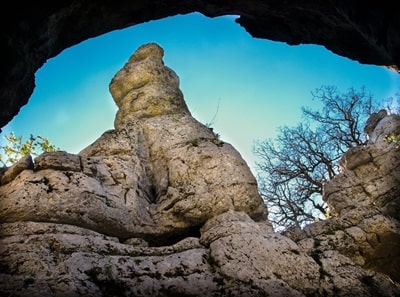 Paiolive Wood is a paradise for botanists, zoologists, and the curious. It is constantly revealing new plant and animal species, often endemic and rare. Among the flowers brightening the landscape, you can admire the almost whitish centaury, with petals tinged with pale pink; Lecoq's centranthus, named after a famous French botanist; the colorful crocus, which blooms with vibrant colors in spring; the small-leaved orchid, a discreet and elegant flower; the large-fruited silver basket, resembling a small white cauliflower; and an epiphytic moss that clings to the branches of trees.
Paiolive Wood is a paradise for botanists, zoologists, and the curious. It is constantly revealing new plant and animal species, often endemic and rare. Among the flowers brightening the landscape, you can admire the almost whitish centaury, with petals tinged with pale pink; Lecoq's centranthus, named after a famous French botanist; the colorful crocus, which blooms with vibrant colors in spring; the small-leaved orchid, a discreet and elegant flower; the large-fruited silver basket, resembling a small white cauliflower; and an epiphytic moss that clings to the branches of trees.
Paiolive Wood is also a refuge for mammals, notably the European beaver, which builds dams and lodges along the river, and for bats (chiropters), these small flying mammals commonly called bats.
It is also a nesting site for many birds, including the European kingfisher, which dives into the water to catch fish, the European eagle owl, the largest nocturnal raptor of the continent, the European roller, with its bright blue and green plumage, the woodpecker, which drums on tree trunks with its beak, the hobby falcon, which hunts insects in flight, the skylark, singing as it rises into the sky, the black kite soaring majestically above the woods, the blackbird known for its metallic blue back, the osprey, capturing aquatic prey with its talons, the common chiffchaff, mimicking the songs of other birds, and the hoopoe, which displays its fan-shaped crest.
***
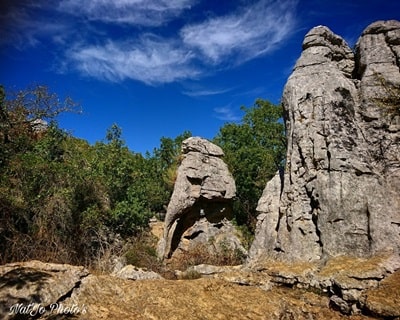 Paiolive is an ancient and mysterious forest located in southern Ardèche. Its strangely shaped rocks, sculpted by erosion, are home to many legends and secrets. Among them is the legend of Jean de la Lune, a young boy living in a cave with his mother, a witch. Jean de la Lune had sky-blue eyes and sun-blonde hair. He loved wandering the woods at night, illuminated by the moon, and gazing at the stars.
Paiolive is an ancient and mysterious forest located in southern Ardèche. Its strangely shaped rocks, sculpted by erosion, are home to many legends and secrets. Among them is the legend of Jean de la Lune, a young boy living in a cave with his mother, a witch. Jean de la Lune had sky-blue eyes and sun-blonde hair. He loved wandering the woods at night, illuminated by the moon, and gazing at the stars.
One day, he met a girl named Marie. She was the daughter of the lord of the neighboring village, and very beautiful. Her eyes were green like the leaves, and her brown hair like the branches. She enjoyed walking in the woods during the day, accompanied by her dog, and picking flowers. When they met, they fell in love with each other. They decided to meet every evening by the Chassezac river, which flows through the forest.
But their love was forbidden, because Jean de la Lune’s mother did not want him to associate with a village girl, and Marie’s father did not want her to marry a son of a witch. They did everything to keep them apart, in vain. Jean de la Lune and Marie continued secretly to meet, dreaming of running away together.
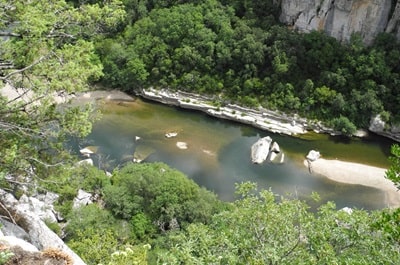 One evening, when they met at the Bear and Lion rock, a triple arch resembling two fighting animals, they were surprised by soldiers sent by Marie’s father. They chased them into the woods, forcing them to the edge of a cliff. Jean de la Lune and Marie took each other's hands and jumped into the void.
One evening, when they met at the Bear and Lion rock, a triple arch resembling two fighting animals, they were surprised by soldiers sent by Marie’s father. They chased them into the woods, forcing them to the edge of a cliff. Jean de la Lune and Marie took each other's hands and jumped into the void.
But instead of dying, they were saved by the magic of the moon, which transformed them into two stars. Since then, they can be seen shining in the sky above Paiolive. They have become the symbol of eternal love, defying obstacles and prejudices.
Paiolive is a place full of history and mystery, inspiring many legends over time. Here are some examples of these fantastic tales:
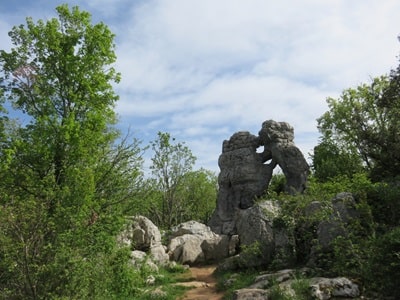 The Legend of the Water Fairy tells of a beautiful young woman living in a hidden spring deep within the forest. She loved bathing in the Chassezac and lured men with her melodious voice. But if one tried to approach her, she would drown them mercilessly. One day, a shepherd named Pierre managed to catch her and bring her home. He kept her locked in a cage, hoping she would fall in love with him. But the water fairy withered away far from her element, begging Pierre to free her. He refused, and she died of grief. Since then, it is said that her plaintive voice can still be heard in the woods, and that the waters of Chassezac are cursed.
The Legend of the Water Fairy tells of a beautiful young woman living in a hidden spring deep within the forest. She loved bathing in the Chassezac and lured men with her melodious voice. But if one tried to approach her, she would drown them mercilessly. One day, a shepherd named Pierre managed to catch her and bring her home. He kept her locked in a cage, hoping she would fall in love with him. But the water fairy withered away far from her element, begging Pierre to free her. He refused, and she died of grief. Since then, it is said that her plaintive voice can still be heard in the woods, and that the waters of Chassezac are cursed.
The legend of the Knight of Casteljau is about a noble warrior who defended Casteljau Castle, located at the entrance of the forest. Known for his bravery and generosity, he loved riding through the woods in search of adventures. One day, he met a beautiful lady in distress, asking for his help to escape a bandit. The knight agreed and fought the outlaw. But it was in fact a trap: the lady was an accomplice of the bandit, and she took advantage of the knight's distraction to stab him in the back with a dagger. The knight fell from his horse and died cursing the traitor. Since then, it’s said that his ghost roams the forest, and his white horse appears to lost travelers, guiding them towards the exit.
The legend of the Bear and the Lion rock describes a triple arch formed by erosion, resembling two fighting animals. According to legend, long ago, a bear and a lion lived in the forest and disputed territory. One day, they decided to settle their disputes with a fight at the edge of the Chassezac. They attacked each other with such violence that the land trembled. Their clash was so powerful that they petrified on the spot, giving birth to the rock named after them. Since then, the rock has come to symbolise strength and courage, and anyone daring to cross it is said to be blessed by nature.
Former holiday hotel with a garden along the Allier, L'Etoile Guest House is located in La Bastide-Puylaurent between Lozere, Ardeche, and the Cevennes in the mountains of Southern France. At the crossroads of GR®7, GR®70 Stevenson Path, GR®72, GR®700 Regordane Way, GR®470 Allier River springs and gorges, GRP® Cevenol, Ardechoise Mountains, Margeride. Numerous loop trails for hiking and one-day biking excursions. Ideal for a relaxing and hiking getaway.
Copyright©etoile.fr